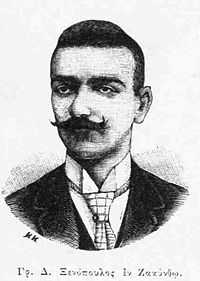Gregorios Xenopoulos
| Gregorios Xenopoulos | |
|---|---|
 | |
| Born |
December 9, 1867 Istanbul, Ottoman Empire |
| Died |
January 14, 1951 Athens, Greece |
| Occupation | Novelist, writer, journalist |
| Nationality |
|
| Genres | Drama, Comedy, Theatre |
Gregorios Xenopoulos (Greek: Γρηγόριος Ξενόπουλος; December 9, 1867 - 14 January 1951) was a novelist, journalist and writer of plays from Zakynthos. He was lead editor in the now-legendary magazine "The Education of Children" (Η Διάπλασις των Παίδων) during the period from 1896 to 1948, during which time he was also the magazine's main author. His was the trademark signature "Σας ασπάζομαι, Φαίδων" ("yours faithfully, Phaedon)", which he used in letters ostensibly addressed to the magazine. He was also the founder and editor of the Nea Estia magazine, which is still published. He became a member of the Academy of Athens in 1931, and founded the Society of Greek Writers together with Kostis Palamas, Angelos Sikelianos and Nikos Kazantzakis.
Life
He was born in 9 December 1867 in Constantinople. His father, Dionysios, hailed from Zakynthos and his mother, Evlalia came from Constantinople. The family moved to Zakynthos soon after, where Gregorios spent his youth until 1883, when he enrolled in the University of Athens to study Physics and Mathematics. He never completed his studies: already in the first year, he had begun writing literature, which was his sole source of income at the time.
In 1892 he moved permanently to Athens and in 1894 he married Efrosini Diogenidis. They divorced one and a half year later, having already had a daughter. In 1901 he married his second spouse Christine Kanellopoulos, with whom they had two daughters.
He cooperated with several newspapers and magazines, in which he published a lot of studies, articles, short stories and novels. In 1894 he became director in the Illustrated Estia newspaper and in 1896 the chief editor of The Education of the Children. From 1901 to 1912 he published literary works and studies in the Panathinaia, and from 1912 he cooperated with Ethnos newspaper, writing serialized novels. In 1927 he founded the magazine Nea Estia, whose director he was until 1934.
He died in Athens on 14 January 1951 and was buried at public expense.
Works
Prose
Xenopoulos was a very notable writer. He wrote over 80 novels and stories. He first became known with his novel: "O anthropos tou kosmou" Greek: "Ο Άνθρωπος του Κόσμου" ("Human of the world"). This New Athenian writer category novel and his next one, "Nikolas Sigalos" (1890), were not successful. He then was inspired by his place of birth Zakynthos,and as a result he wrote some of his best novels: "Magaret Stefa" (1893), "Kokkinos Vraxos" "Red Rock" (1905). Then he wrote some New Athenian writer category novels: "O polemos" "Ο πόλεμος" "The war" (1914) and "I mistikoi aravones" "Οι Μυστικοί Αρραβώνες", "The secret engagements"(1915) and the Ionian writer category novel "Laura" (1915), which was also one of his best. But his most ambitious work was the trilogy: "Πλούσιοι και φτωχοί" "Rich and poor" (1919), "Τίμιοι και άτιμοι" "Honest and dishonest" (1921), "Τυχεροί και άτυχοι" "Lucky and unlucky "(1924). Other novels are: "Anadiomeni" "Αναδυομένη" (1923), "Isabel" "Ισαβέλλα" (1923), "Teresa Varma-Dakosta" "Τερέζα Βάρμα-Δακόστα" (1925).
He is the rapporteur of urban prose.
Theatrical
His first theatrical play was: "O Psixopateras" (Greek: "Ο ψυχοπατέρας", The lighthearted father), and was presented in 1895. He cooperated with "Nea Skini" (a theatre) of Konstantine Christomanos. His most famous theatrical plays are: "To mustico tis kontessas Valerenas"(The secret of countess Valerena) (1904), η "Stella Violanti" (1909, with Marika Kotopouli), "Fititai". He wrote 46 different theatrical plays. In 1901 he was in the font line with Kostis Palamas, in order to establish the theatre "Nea Skini" and because he was fluent in a lot of languages, he was aware of the several important spiritual events that took place in big European countries at that time. In addition, he wrote introductions for Henrik Ibsen and he was "living" the theatrical acts.
He made a lot of translations and his writing was of high standards. The first act that was played in "The Royal Theatre" of Athens (renamed after renovation in 1932 as National Theatre of Greece) was his: "O theios Oniros" (Greek: "Ο θείος Όνειρος", means "The Uncle Dream").
Categories of works': He wrote Dramas και Comedies with the common subject: love. His work is a window to his times Greek Society. His works are categorized by theplace that they were written. Some in Zante and the rest in Athens. It seems that he tries to balance between "The Ionian writers" and "The New Athenian writers" category of writing. Zakynthian: "Stella Violanti", "Rachil", "Fotini Saranti, "O popolaros" The secret of Contessa Valeriana.
Athenian: "Fititai" (Students), "Psixosavato", "To anthropino".
Literary criticism
Xenopoulos is notable for his literary criticism. In magazine "Panathinaia" (Greek: "Παναθήναια"), he published a lot of reviews on famous Greek writers, like Alexandros Papadiamantis, Demetrius Vikelas etc. In 1903 he was the first to introduce Constantine P. Cavafy to the Athenian readership.
Bibliography
- Apostolos Sachinis, To neoelliniko mythistorima, Galaxias ed., Athens 1971.
External links
- Μουσείο Γρηγορίου Ξενόπουλου (Museum Gregorios Xenopoulos in Zante).
- Ε.Λ.Ι.Α. (Bibliography).
|